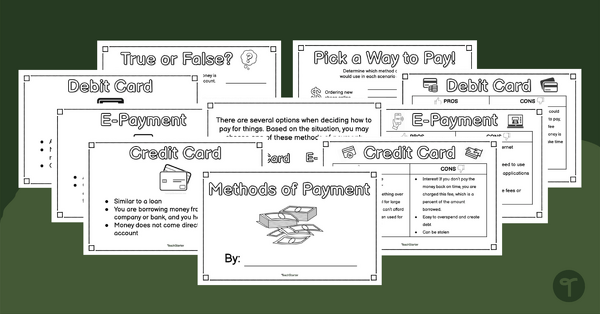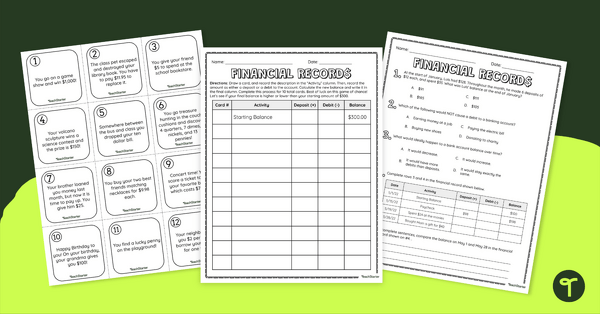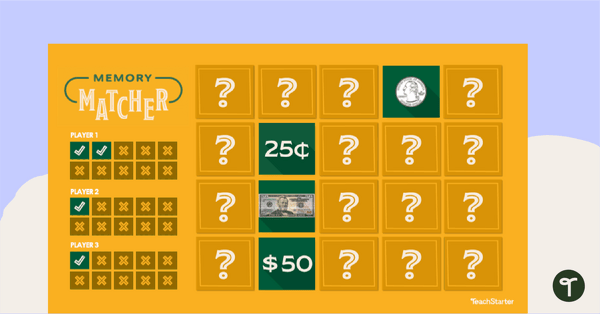Money Teaching Resources
Teaching money math in first or second grade this school year? Whether you need fun worksheets, counting money activities, word problems about dollars and cents or fun digital games to get kids thinking about how to count coins and bills and how to make change, we've got you covered!
This collection of printable and digital resources covers the money curriculum standards for both TEKS and Common Core math with worksheets, games and plenty more. Best of all, each resource in the collection was created by a teacher and reviewed by a member of our expert teacher team to ensure it's ready for your lesson plans and your students.
Teaching kids about money for the first time this year? Or maybe you just need a quick guide to make your lesson planning easier? Read on for a primer from our teacher team. We cover a definition of money you can use to explain currency to kids, a look at the different bills and coins in circulation and who is on each, plus tips on bringing this real-world math concept into the classroom!
What Is Money? A Kid-Friendly Definition
If you explore the Teach Starter site, you'll find it's chock full of simple definitions for common concepts that our teacher team has created just for you. Of course, that applies to the meaning of money too!
Here's how our teacher team explains money to our students:
Money is something that we use to exchange for goods or services.
For example, if you want to buy a new video game, you will need money to pay for it!
What Is a Dollar? A Kid-Friendly Definition
Dollar is another vocabulary word key to teaching students about money.
A dollar is the basic unit of money that we use in the United States.
Some other countries around the world, including Australia and Canada, also base their money system around the dollar.
To represent a dollar, we use a special symbol called the dollar sign, which looks like this: $.
What Is a Cent? A Kid-Friendly Definition
A cent is another unit of money that is used in the United States. It is equal to one hundredth of a dollar.
To represent a cent, we use a special symbol called the cent sign, which looks like this: ¢.
Bills vs. Coins — American Currency Explained
Currency is a word that we use to describe the form of money that we use to pay for things.
American currency is made by the United States Mint and the Bureau of Engraving and Printing, two special parts of the federal government.
There are two types of American currency — bills and coins. These bills and coins each have numbers assigned to them that let us know their value. For example, an American penny is equal to a value of one cent, while an American dollar equals 100 pennies or 100 cents.
Let's break down the differences!
American Bills
Created by the Bureau of Engraving and Printing, American bills are a type of currency sometimes called paper currency, because it's made from a special material that feels like paper.
There are seven different American bills that you might find in your piggybank or at the grocery store, including:
- $1
- $2
- $5
- $10
- $20
- $50
- $100
The US government once printed $500, $1,000, $5,000, and $10,000 bills, but these denominations of paper currency are no longer in circulation.
American Coins
In addition to the paper currency that is used to pay for goods and services in the US, American currency is also made up of a variety of coins. Currently, you'll find six different denominations of coins in circulation.
These coins are all made from different metals, and they include:
- Penny — Valued at 1 cent
- Nickel — Valued at 5 cents
- Dime — Valued at 10 cents
- Quarter — Valued at 25 cents
- Half-Dollar — Valued at 50 cents
- Dollar coin — Valued at $1
Each American coin is made by the US Mint, which creates more coins than any other place in the world!
Who Is On American Money?
All of the American bills and some of its coins feature people on them, which can make it easy to tell which piece of currency is which.

So, who has been selected to represent America on its money? That answer depends on the exact piece of currency!
- George Washington — The first president of the US appears on both the $1 bill and the 25-cent coin (more commonly known as the quarter).
- Thomas Jefferson — The nation's third president, President Thomas Jefferson is also on more than one piece of currency. His face can be found on both the American $2 bill and the nickel.
- Abraham Lincoln — The first president to appear on American money, President Abraham Lincoln appears on both the penny and the $5 bill.
- Franklin D. Roosevelt — The only president to ever serve more than two terms in office, FDR is on the American dime.
- John F. Kennedy – If you find a 50-cent coin, you are likely to find our nation's 35th president. JFK was added to the half-dollar in 1964.
- Benjamin Franklin — The $100 bill is sometimes referred to as a Benjamin because it features the face of this founding father. Franklin was also on a 1948 version of the half dollar.
- Alexander Hamilton — The first secretary of the US treasury, Alexander Hamilton has appeared on the nation's $10 bill since 1929.
- Andrew Jackson — President Andrew Jackson was initially on the $10 bill before it was changed to include Hamilton. Since then, the seventh American president's face has been found on every $20 bill issued by the US Department of Treasury.
- Ulysses S. Grant — The former president and former Civil War general has been on the $50 bill since it was first issued in 1914.
- Sacagawea — A Lemhi Shoshone woman known for helping explorers Lewis and Clark, Sacagawea is honored on the $1 coin.
- Free Plan

Financial Literacy Math Investigation – Pop–Up Shop on Wheels
A mathematics investigation involving financial literacy, embedded in a real-world context.
- Plus Plan

Math in the Real World - Budgeting Planning Project
Introduce your students to the world of making a budget with an immersive “It’s My Life” budgeting for kids project.
- Free Plan

Counting Mixed Coins Differentiated Worksheets
Download differentiated printable worksheets and use skip counting and addition skills to determine the value of each coin collection.
- Free Plan

How Much Is It? - Money Task Cards
A set of 12 money word problem task cards.
- Free Plan

Count the Nickels Worksheet
Use skip counting and addition skills to determine the number of nickels needed for a given amount.
- Plus Plan

Back to School Supply Shopping Task - Primary Grades
Calculate the cost of school supplies and answer questions with this back-to-school math activity.
- Plus Plan

Identifying Coins Interactive Activity
Practice coin recognition and value with this 4-activity slide deck introducing penny, nickel, dime, and quarter images and denominations.
- Plus Plan

Money – Word Wall Template
A set of money-themed word wall cards.
- Plus Plan

Pandora's Party Palace Math Activity - Middle Years Version
16 mathematics problem solving task cards involving money in a real-world context.
- Plus Plan

Financial Literacy Word Wall
Use this set of financial literacy vocabulary cards when teaching about income, budgets, taxes, methods of payment, and financial records.
- Plus Plan

Balancing a Budget – Worksheet
Practice how to balance a budget with this financial literacy worksheet.
- Plus Plan

Financial Literacy for Kids - Finance Word Wall
Introduce your students to the world of financial literacy with an illustrated personal finance word wall for kids.
- Plus Plan

Back to School - Plan a Field Trip Project
Integrate STEM activities into your beginning-of-year math and economics lessons by inviting your students to plan a field trip, calculate costs, and follow a budget.
- Plus Plan

School Supply Shopping - Upper Grades
Calculate the cost of school supplies and answer questions with this back-to-school math activity.
- Free Plan

Rolling for Cash — Printable Counting Coins Game
Print a customizable money game for kids that requires addition and skip counting skills to count coins.
- Plus Plan

Calculating Discounts and Sale Price Teaching Slides
Teach your students how to calculate discounts and sale prices using fractions and decimals with this comprehensive teaching presentation.
- Plus Plan

Pandora's Party Palace Math Activity - Upper Level Version
16 mathematics problem solving task cards involving money in a real-world context.
- Plus Plan

Money Bingo (US Currency)
32 different bingo cards using bills and coins.
- Plus Plan

Math Investigation - Decimals and Percentages
Get your students connecting their math knowledge to the real world with this decimals and percentages party planning project.
- Plus Plan

American Currency Posters - Coins
Use these money posters to teach your students about coin recognition and value.
- Plus Plan

Methods of Payment Mini-Book
Learn about the advantages and disadvantages of different methods of payment with this mini-book.
- Plus Plan

Types of Taxes – Sorting Activity
Differentiate between different types of taxes with this 24-card sorting activity.
- Plus Plan

Financial Records Independent Game
Engage your students with an independent game while learning how to keep and use financial records.
- Plus Plan

Gross and Net Income – Task Cards
Explore the difference between gross income and net income with this set of 24 task cards.
- Plus Plan

Presidents' Day Finger Puppets
A set of finger puppets and writing templates that students can use around Presidents' Day.
- Plus Plan

Financial Literacy for Kids - Instructional Slide Deck
Teach your students the ins and outs of financial literacy with an instructional slide deck.
- Plus Plan

Memory Matcher PowerPoint – American Coins and Bills
Practice identifying US coins and bills with an interactive memory match game.
- Plus Plan

Counting Coins - Interactive Activities
Practice creating amounts up to a $1.00 with a variety of coins.
- Plus Plan

Ordering American Coins – Worksheet
Practice ordering American coins from least to greatest with this cut and paste activity.
- Plus Plan

High Dollar Words Worksheet-Spelling Center
Develop spelling and mathematics skills simultaneously with a differentiated spelling and money math center activity.
- Plus Plan

Count and Color the Coins - Differentiated Worksheets
Use skip counting and addition skills to determine which coins are needed for a given amount.
- Plus Plan

I Have, Who Has? - Coin Game
Practice counting a collection of coins with this set of “I Have, Who Has” game cards.